Our calendar is replete with a large number of different holidays, which, in turn, differ not only in their name and origin, but also by the presence of traditional dishes. Such dishes are symbols that are always recognizable and loved. One of the largest and most revered holidays among Christians is Easter, a symbol of which has always been a cake.
Content
Warm, fragrant, tall, with a crispy crust of the cake is certainly present on the festive table in every family. There are a large number of dough recipes for Easter cake. You can use both Old Russian recipes and more modern ones. Also, many recipes were adopted from European cuisine and with small changes are very successful in our hostesses.
In this article, we consider the history of the creation of Easter Easter cake, as well as the basic rules for its preparation. We will describe in more detail the phased process of preparing various types of cake dough.
History of Easter Easter Easter
Kulich is a special, festive pastries that occupies a central place in the Easter breakfast menu, lunch and dinner. By tradition, cakes must be baked on a clean Thursday or on Saturday before Easter. Until that time, the whole house should be removed and clean. After all, this holiday is the real principle of bright and warm spring, the beginning of something new and good. According to the custom of our ancestors, Easter cakes need to be closed on Thursday evening, then the Easter cakes are baked all on Friday, and on the night of Saturday to Sunday they illuminate in the church. This is a long and time -consuming process, but it was it that our grandmothers and great -grandmothers adhered to it, preparing for the bright holiday of Easter.
Delicious butter cakes could be eaten until the Radunitsa itself. They were treated to all relatives who entered the house of guests.
Since Easter is inherently an Orthodox religious holiday, the history of the appearance of Kulich is directly related to religion and Jesus Christ. Kulich is identified with the main bread on the table of every family on this holiday, since before serving on the table he is consecrated in the church. Easter cakes have been known in the world since ancient times. Such bread was baked by the Slavs. During Jesus Christ, during his meal with his disciples in the central part of the table, round bread always lay for him. Before his death, he was fresh, but after the resurrection of Jesus Christ, the disciples began to put on the table only screaming bread.
It is this essence that is laid down in the modern traditions of baking Easter cakes. It is important to purchase the highest quality and good products, not sparing to add more milk, oil and eggs to the dough.

Rules for preparing delicious cakes dough
- In order for the dough for the cake, the recipe of which you use, it turned out perfect, do not make it too liquid or very thick. If the dough is very liquid, your cake is blurry and will become flat. With a thicker test, the cakes can turn out to be too dense and quickly become stale.
- The secret of a delicious and soft cake is long -term mixing of the dough. It needs to be kneaded until it is easy to lag behind the hands and table without pouring flour. In addition, it should be well separated by a knife.
- When preparing a dough for Easter cakes, it is necessary to take all products of the same room temperature. There should not be sudden differences, for example, if eggs are from the refrigerator, and oil temperature oil.
- The ideal dough for cakes should be suitable for at least three times. The first time is suitable for dough, then the dough is suitable with all added products. The last time the dough is suitable in the forms before baking.
- In order for the dough to rise well, be sure to create an optimum temperature for him, which should be at least 25 degrees. And optimally about 30-40 degrees.
- At the time when the dough rises, there should be no drafts and a sharp decrease in temperature in the room.
- The baking forms must only be filled with dough, since it should rise again.
- Before putting the dough in the oven, stick a toothpick or skewer in the middle. So your kulich will rise evenly. And taking out a toothpick after a while, you can find out about the readiness of the Easter cake.
- Bake cakes in a moistened oven. To do this, put a container with water to the bottom of the oven.
- Remember that for each cake there will be its baking time. You can focus on the following indicators: if your cake is less than 1 kg - baking time 30 minutes, 1 kg - 45 minutes, 1.5 kg - 1 hour, 2 kg - 1.5 hours. These are approximate indicators, focus on your oven.
- If your wonderful Easter cake began to burn on top, cover it with baking paper.
- The cake should cool on the side.
Compliance with all these rules will help you make a very good dough and eventually get a delicious and aromatic cake. The dough for Easter cake can be completely different. Consider several options for the cake of the kulich step by step.

Alexandrian dough for Easter cakes
The Alexandria dough for Easter cakes is one of the most popular among modern hostesses. It is rather traditional and combines the most remarkable qualities of Easter cake: softness, airiness, aroma and a very pleasant creamy taste. Since Easter happens once a year, you can afford to make Easter cakes from the Alexandrian dough, because for him you need a pretty decent amount of butter, milk, eggs. They love to use it for baking due to a large number of cakes that are obtained from one portion. You can make 1/3 or 1/4 of the indicated ingredients without problems and you will get 2-3 cakes for the family.
Another feature of the Alexandrian dough is a longer time to raise the dough in comparison with other recipes for cakes dough. But during this time the dough rises very well, it becomes very soft and airy. Easter cake from the Alexandrian dough will be a real treat for the whole family at the festive table at a cup of fragrant tea.
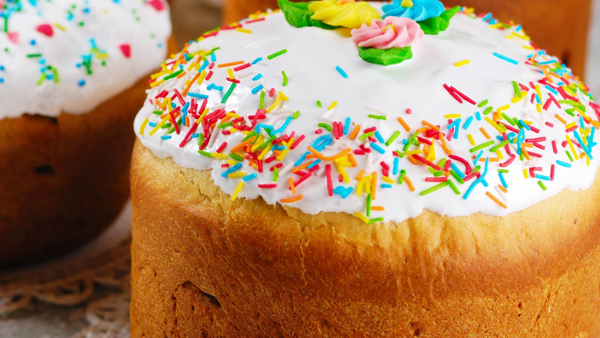
Alexandria dough for cakes - ingredients
- Milk (it is better to take ghee, which is also sold in the store) - 1 liter.
- Sugar - 1 kg.
- Good quality butter - 500 grams.
- Fresh eggs - 10 pcs.
- Yellow (for lubrication of cakes) - 3 pcs.
- Yeast (necessarily fresh) - 150 grams.
- Salt - 1 tsp
- Raisins or walnuts-200 grams (you can add centers instead of raisins or something else to taste).
- Vanilin-2-3 grams (or 1-2 bags).
- Cognac or rum, you can use the liquor - 2 tbsp. (for raisins).
- The flour of the highest brand is 2.5 kg.
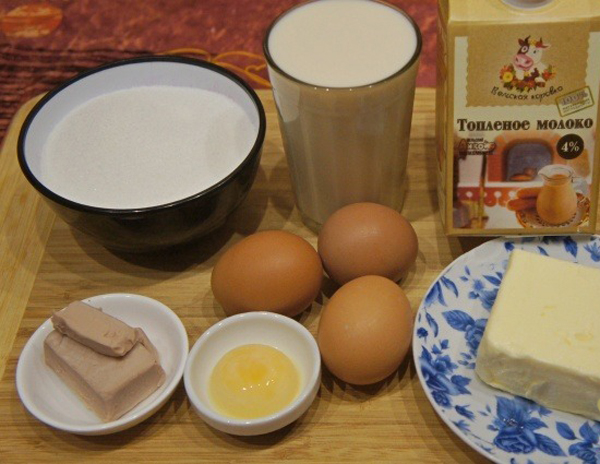
All ingredients should be of the highest quality and necessarily room temperature. From this number of products, approximately 5 kg of cakes are obtained. If you need less, boldly divide by 2 or even by 3.
Alexandria dough for cakes - recipe preparations
- First of all, we prepare dough for the Alexandrian dough for Easter Easter cakes. Beat together 10 eggs and 3 yolks (you do not need to beat hard). Add sugar to the eggs, mix everything thoroughly. Then cut the butter into small pieces and add to the future dough.
- Heat ghee, but do not boil. Add broken fresh yeast to it and mix well. Pour milk milk into a pre-prepared egg-oil mixture.
- Put the prepared dough to approach a warm place without drafts for 10-12 hours.
- Before starting working with the test, soak clean raisins in boiling water. It can also be soaked separately in cognac or rum. Or add aromatic drinks separately.
- After your academ is suitable, you need to add all the other ingredients of our Alexandrian dough for Easter cake. Immediately add salt, vanillin or vanilla sugar, then cognac or raisins soaked in it. Mix everything thoroughly and add pre -sifted flour. Pour the flour gradually, kneading the dough well after each portion of flour.
- If the dough sticks strongly to your hands, you can moisten them with vegetable oil. The dough should eventually turn out to be sticky.
- Leave the dough to rise in a warm place, covering the container with it with a film or towel. It is necessary to wait until it doubles. It goes to it for about 1-1.5 hours.
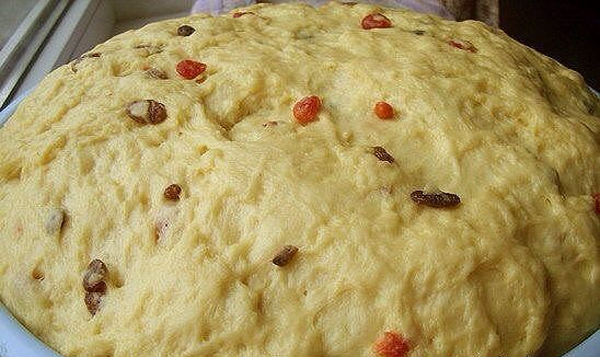
- After an hour and a half, the dough should double. It needs to be linked once again and lay out in molds by about 1/3 of their heights.
- Give the dough again to rise, approximately to fill 3/4 of the volume of molds.
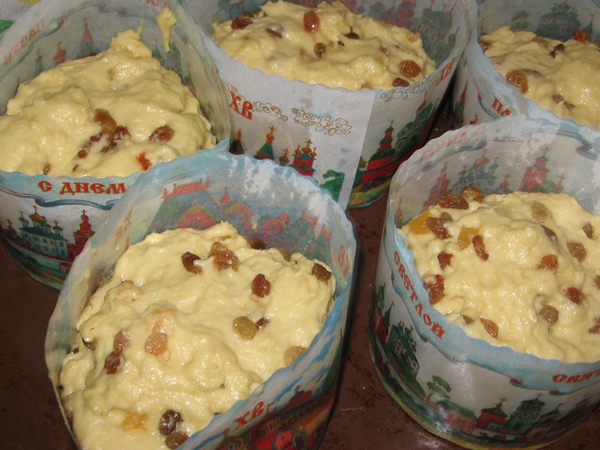
- You can put the Easter cakes in an already preheated oven up to 180 degrees for 40 minutes, or you can place in a cold oven and gradually increase the temperature. It looks something like this: first turn on the oven for 100 degrees and bake the cakes for 10 minutes, then increase the temperature to 150 degrees and bake for another 15 minutes, then increase the temperature to 200 degrees by 150 minutes. After this interval, cakes of medium size should be prepared. At this stage, you can open the oven and checked with a toothpick or skewer the readiness of the cakes. If they are still damp, leave to bake for 15 minutes at 200 degrees. Easter cakes can be covered with wet bakery paper so that the crust does not burn on them.
- After the cakes are baked, leave them in the oven for about 30-40 minutes. Remove the cake and put it on the side without getting it out of the form.
- After cooling cakes, take them out of molds and decorate them according to your desire and preferences.
Alexandrian dough for cakes - reviews of the hostesses
On the Internet, various culinary and women's sites, as well as forums, you can find a large number of reviews on the Alexandria dough for Easter cakes. Judging by them, one can confidently say that from this test there are very soft, fragrant and delicious Easter cakes that will make even the most demanding gourmets.
“I hasten to bring you another recipe for Easter cake on the Alexandria test. Today I baked, very delicate and air crumbs, not dry ... Of all the options that I tried this year - this is the best! ”
“About 5 years old on this recipe! Very tasty dough !!! I recommend everyone ... "
“I baked according to this recipe - a miracle of Easter cakes is obtained! The preparation is quite simple, you can have time to do without problems, even if you have little children and a lot of housework! ”
Viennese cakes dough
In addition to the above test for Easter cakes, there are still a large number of recipes with which you will get delicious cakes for the holiday. Viennese dough is an excellent option for a butter of yeast dough for Easter cakes. It turns out very tasty, soft, air cakes that do not stale for a long time, and you will eat them until the Radunitsa itself. This test recipe came to us from Austria, where delicious butter buns is prepared on its basis.
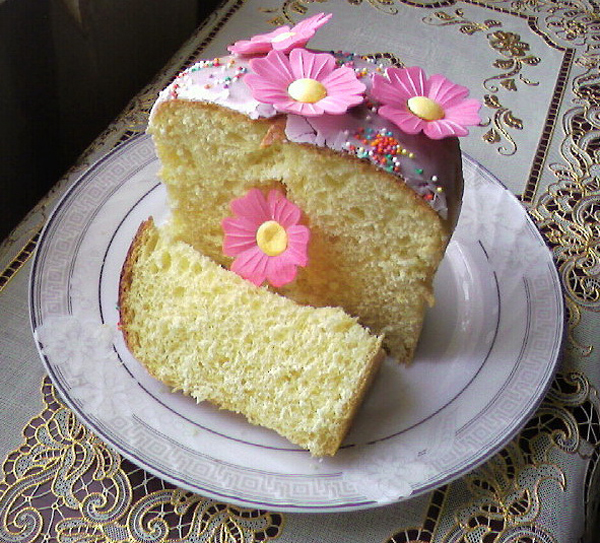
Viennese cakes dough - ingredients
- The highest quality flour (sifted) is 1.5 kg.
- Fresh yeast - 50 grams.
- Milk (cow or vegetable) - 0.5 liters.
- Butter (can be replaced with margarine) - 300 grams.
- Sugar - 0.5 kg.
- Fresh eggs - 6 pieces.
- Salt - 1 tsp
- Raisins - 300 grams (it can be replaced with centers or nuts, amateurs can add raisins and zuccats).
If you want to bake a couple of small cakes in forms of 11 cm in diameter, then the ingredients must be taken at the rate of 0.5 kg of flour.
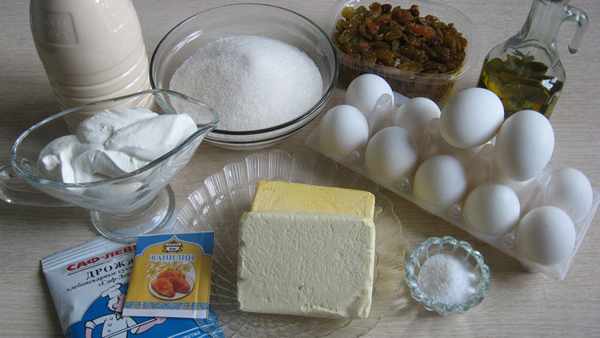
Viennese cakes dough - recipe for cooking
- We begin to prepare the Viennese dough with a bacher. To do this, slightly beat the eggs with the indicated amount of sugar.
- Melt butter or margarine on the stove and carefully pour it into the egg mixture.
- Heat milk a bit and dissolve the yeast in it. Mix everything thoroughly.
- Next, connect milk with yeast and egg-oil mixture. Mix well.
- Cover the container with a fall of a film or a towel and put in a warm place so that the dial rises. It takes about 8-10 hours, so it is best to leave it overnight, and in the morning to start baking.
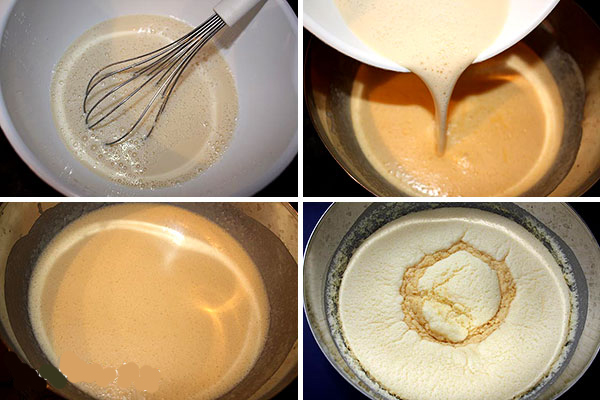
- Before kneading the dough, raisins must be soaked in boiled water for about 20 minutes, and then it is well dried with paper towels.
- Add salt and raisins to Opara, mix everything well.
- Lastly, pour flour sifted through a sieve into the Vienna dough. It is best to do this in portions, after each addition, mixing everything thoroughly.
- The dough needs to be kneaded well. This must be done until we begin to lag behind the hands and table without flour.
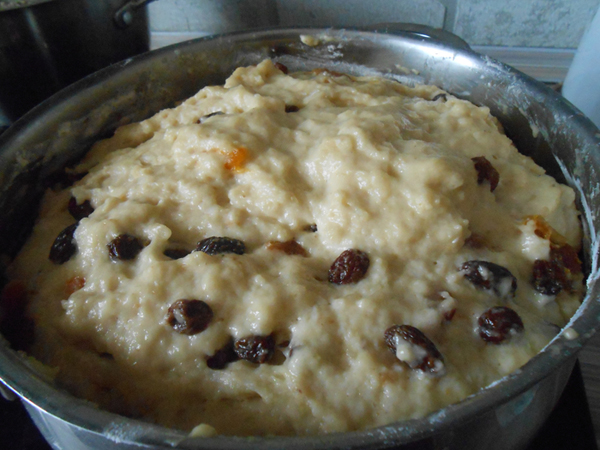
- You can start filling the molds. A variety of forms are suitable for Easter cakes: metal, ceramic or paper. All forms, except paper, need to be lubricated with vegetable oil. Fill the forms by about 1/3 of the part.
- Leave the dough in the forms for about 1-1.5 hours. The dough should rise to 3/4 parts of the molds.
- Pre-heat the oven to a temperature of 180-200 degrees and place Easter cakes in it. Depending on the size of your cakes, you need to bake from 30 to 50 minutes. During the baking, the door of the oven cannot be opened. You can check the cakes for readiness using a toothpick.
- After cooling cakes, decorate them at your desire.
Asso cakes dough on sour cream
A buckthorn dough is a large number of eggs, butter and sugar. Only with such a combination you will receive a really real festive Easter cake, the aroma of which will be in your house for a long time. In such a butt dough, do not regret add raisins, walnuts, zuckets, dried apricots to your taste.

Asso dough for cakes - ingredients
- Sour cream - 200 grams.
- Fresh yeast-25 grams (you can take dry, if they are more familiar to you-about 1-1.5 tsp).
- Milk cow - 170 ml.
- Butter or margarine - 50 grams.
- Sugar - 150 grams.
- The highest quality flour is 650-700 grams (focus on the test).
- Fresh eggs - 3 pieces.
- Cognac-2-3 tbsp. (can be replaced with rum).
- Raisins-50-100 grams (first need to scald with boiling water).
- Vanilin-1 bag (1.5-2 grams).
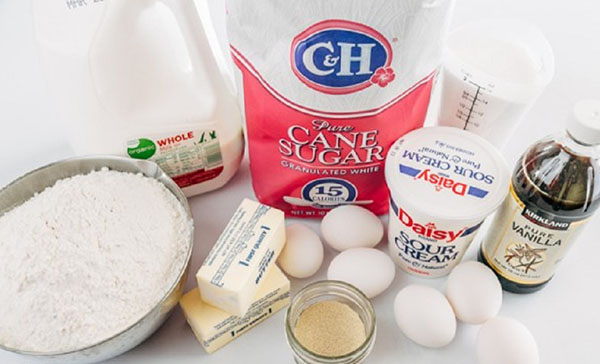
All ingredients must be taken the same room temperature.
Asso cakes dough - recipe for cooking
- First of all, it should be noted that in this test it is not necessary to do dough.
- Previously, you need to scald the raisins with boiling water and rinse it well. Then pour it with cognac.
- Heat milk a bit, after pouring 2 tbsp. milk in an additional container.
- Dilute the yeast in milk and mix well.
- Since we need 1 yolk to lubricate the cakes, separate it before stirring the eggs.
- Beat the rest of the eggs with sugar to a white state, gradually add sour cream and beat all together.
- Add yeast with milk to the eggs, stir and pour salt.
- At the end, begin to introduce flour sieved through a sieve. Add it in parts to knead well.
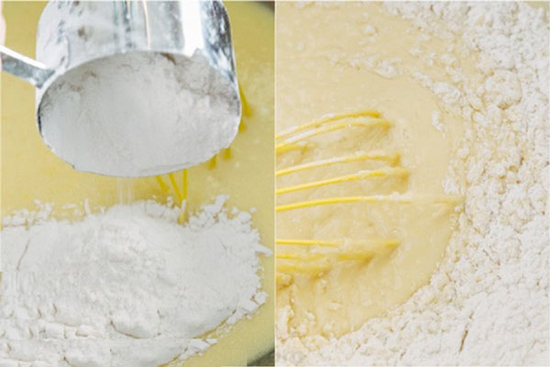
- The dough should turn out to be very soft, do not be alarmed if it sticks to your hands.
- Cover the container with the dough with a towel and put in a warm place for about 30-40 minutes.
- After this time, you need to add butter at room temperature to the dough, and then mix it well.
- Give the dough to approach for 1.5-2 hours.
- The rising dough is well tinned and add raisins dried with paper towels. After that, the dough must be kneaded very well so that the added raisins are evenly distributed throughout the volume.
- Our butt dough can be distributed by molds! All forms are pre -lubricated with vegetable oil.
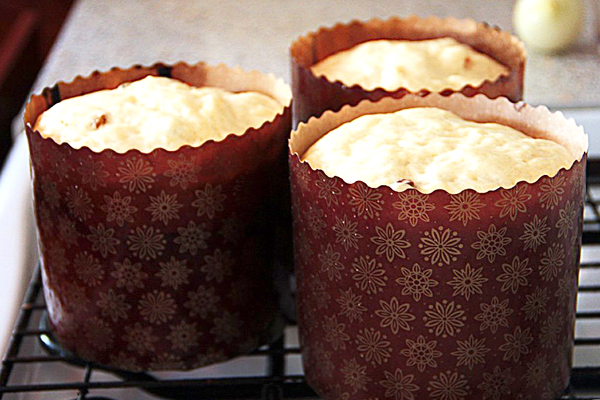
- The test in the forms also needs to rest a little and come. Focus on the volume of dough - it should double.
- Before sending you to the oven, grease each cake in a beaten yolk with 2 tbsp. milk.
- Heat the oven to 200 degrees and bake for about 30 minutes.
In addition to the above dough recipes for Easter cakes, there are a lot of options for preparing this tasty and aromatic muffin.
- For those who follow the figure and are not a yeast dough, you can cook cakes on a non -free -free test.
- The tender and soft dough is obtained, which is prepared by heating in a water bath.
- You can cook Easter cakes using cottage cheese dough.
- Many classic recipes for cakes dough change and adapt to the tastes of specific cooks and housewives. Easter cakes will differ from various additives: saffron, cardamom, chocolate drops, nuts.
Easter is a bright and clean holiday, which is prepared very carefully. It is impossible to imagine this holiday without deliciously smelling cakes that are prepared by your hands. Refuse to buy this mock in the store, and spend a little time on its baking. You will get surprisingly tasty cakes and the aroma of homemade creamy compass at home.









Comments
a couple of years ago, there was no side of metrogils from the same problem, there were no side effects ...
I’m not a fan of peeling at all, it saves from acne of metrogil, it also smoothes it ...
Great article! ...
I take the second course of the Capsules Climafite 911. The tides went very quickly. It became calmer, irritability went away and I sleep well ...
i also noticed - it is worth nervous, everything immediately affects the face. Therefore, I try to avoid conflicts and unpleasant people. Of the creams, I like Miaflow from wrinkles - smoothes not only small wrinkles ...